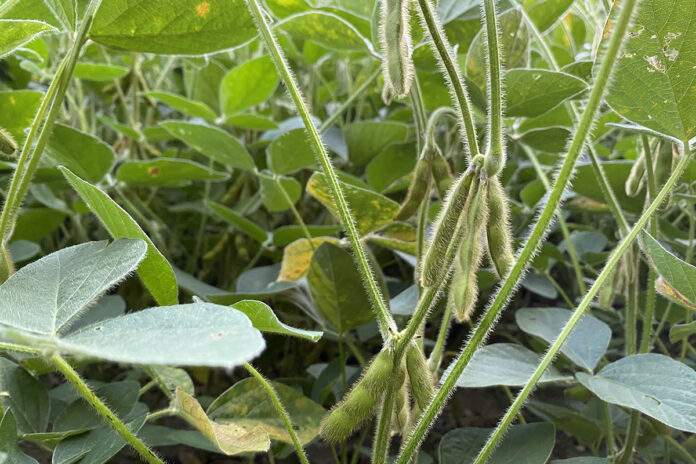
The crop year is winding down fast. Dry conditions over the last month in Ohio have some corn fields fired up and pushing maturity of a crop that started up behind. Soybeans in some areas of Ohio are short, but others are over knee-high and looking good.
If I were any good at estimating soybean yields, which I am not, I would still be wondering how we will come out. What we know is this: Officially the crop year ended the last day of August, and corn is being harvested in the country.
I was told this morning that Texas is now 65% harvested. Of course, that is like using Ashtabula County as a measuring stick for harvest progress. Tell me about Story County, Iowa, and I will pay attention.
Some areas of Midwestern states are seeing harvest, however. The driest areas of Kansas and Nebraska have combines rolling into fields where dry weather pushed the maturity of a late-planted crop that we were worried about.
Still, most farmers are not talking about a drought-fueled disaster, but a crop that will be 170 bpa instead of 200. Other farmers are talking good yields if they got the rains.
This late-season talk all leads to the idea of uncertainty, especially in the corn. Corn prices only gained one and a half cents last week, but that came as a recovery after a dive in the middle of the week.
For the month, December corn futures gained a healthy 571⁄4 cents. Unfortunately, this itself was a recovery, and we are still just in the middle of the summer price range.
December futures put in the contract high May 6 at $7.661⁄4. By July 22, we had lost over $2, to a low of $5.613⁄4. Near the end of August, we got back to $6.833⁄4, but we were trading at $6.661⁄2 the morning of Sept. 6.
Soybeans
November soybean futures were actually down almost 41 cents last week. The biggest factor here might be economic problems in China, as the government there locked down a city of 21 million people due to COVID.
The Chinese have bought beaucoup beans in the last two years, fulfilling our Phase One trade agreement. Remember, that was only a three-year agreement. The Chinese still need our beans, but we still need their market.
We still have “beans in the teens,” with November futures currently trading $14.053⁄4. That is a long way from the $15.843⁄4 we had for a contract high June 9. We have been as low since then as $12.94 3⁄4 July 21, so we have regained roughly a third of the drop.
Prepping for report
Dominating the markets for the next few days will be positioning ahead of the Sept. 12 U.S. Department of Agriculture crop production report.
At the moment, the market believes that the corn yield might be reported lower and the soybean reported higher than in the August report. That, of course, remains to be seen, but any deviation from market expectations could have disproportionate reactions when reflected in current prices.
The fact is that we are tight in supply when we look at the coming crops and any changes in what we think the crops will yield are critical. Right now, the market is thinking we will have a 173 bpa. This is four less than the first USDA estimates of 177 bpa, another two or three bushels below the August estimates.
With the current carryout projection at 1.388 billion bushels, a decrease could get us into the 1.2 billion-bushel range. This is in the range of pipeline supply and would be a dramatic market factor. The situation is probably worse in soybeans.
A good August has actually bettered soybean yield prospects, but there are ideas of 51 bpa, even though the average trade guess is closer to 52. The lower yield would get us to a carryout of below 200 million bushels, and that is probably below pipeline supply and would result in supply rationing.
Adding to the possible impact of lower soybean yield estimates on the market is the fact that the large spec position is only 33,000 contracts long. This means that any fundamental change, such as a lower yield, could cause the spec funds to buy futures, bidding up prices.
Ukraine
So, the summer passed with no huge excitement except in the political arena with the war in Ukraine. The war news has faded, although the long-term effects of the war have not. The Russian have agreed to let Ukraine load out vessels in the Black Sea. Of course, they have continued to shell the ports, so that is a mixed message.
The markets reacted strongly a few weeks ago to the idea that grain was going to leave Ukraine. So far, more than 50 ships have left ports there, and a few actually got loaded with wheat instead of corn. The tale of the first ship out, however, is an indication of the real effect of current export efforts.
That ship, the Razoni, made port in Tripoli, got its corn cargo rejected for quality (no real shock since the corn had been loaded Feb. 24, the day of the Russian invasion). The ship then turned off its transponder so it was harder to track, and finally found a corn home in Syria.
So, a little of the grain that normally exits Ukraine, grain that was not stolen by the Russians or burned in the fields, or stranded in damaged port facilities, has now reached a destination. Don’t get enthused about this export program just yet.











